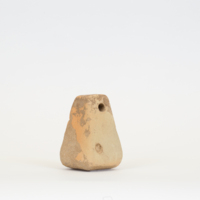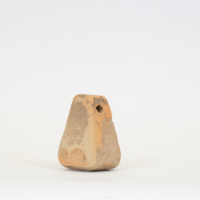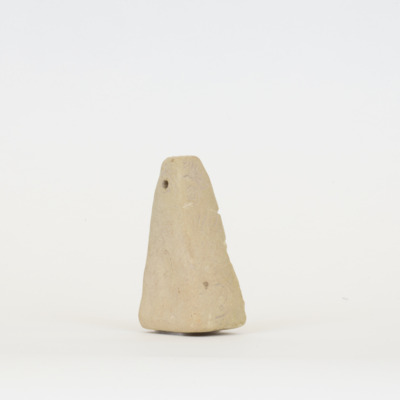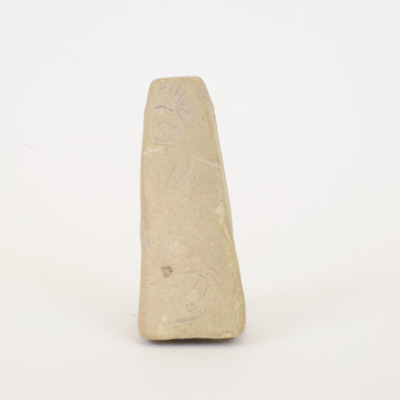Textile Production in Peucetia
Loom Weights in Settlement Contexts: Textile Production in Peucetia
The main productive activities in Peucetia were cereal (barley and durum wheat) cultivation on the coastal plain, and sheep-raising on the Murge Plateau and in the Bradano River valley for milk, meat and wool.[1] By the 6th century BCE sheep husbandry was practiced for textile production, induced by urbanization and the market demands of an emerging elite for fine woolen textiles. Market growth led to technological changes involving specialization, the standardization of textile production tools, and the introduction of new tools and weaving techniques, all of which resulted in more complex industry models.[2] Unlike textile production, raising sheep was a relatively simple enterprise, and did not require any complex technology; in addition, unlike the cultivation of certain plants for (thread) fibre, it did not require prime agricultural land and all of the work necessary for successful harvests of fibre-producing plants. Sheep however, had to be moved around to different pastures, since the same area of land was insufficient to feed a flock over the course of a year. This fact, combined with the extreme climate patterns of Apulia meant that raising sheep for the wool market necessarily involved transhumance (the seasonal migration of shepherds and their flocks between the mountains and the plains) on a broad scale over great distances for maximum wool production.[3]
That weaving and textile production became a widespread activity and an important economic base in Peucetia is demonstrated by loom weights, predominately truncated pyramidal types like those in the Donati collection, found at all sites from all over the region by the 6th century BCE. At Monte Sannace sets of loom weights ranging in number from 20 to over 80, were found at several houses, suggesting the town was a centre of textile production.[4] A second centre of production was located at Botromagno (the ancient site of Silvium, near Gravina), where over 500 loom weights were found, indicating that it too was an important weaving centre in pre-Roman times. Virtually no spindle whorls were found at the site, suggesting that it specialized exclusively in weaving, while the processing and spinning of the fleeces into the yarn were undertaken elsewhere.[5] This type of specialization is documented at other weaving centres in southern Italy, starting in the 6th century BCE or a bit earlier. Silvium was located at the intersection of two main drove roads, and on the main route in the Brandano valley, that crossed the Murge Plateau and linked the inland towns (as far north as the Tavoliere) to the Greek coastal towns of Metapontion (Metaponto) and Taras (Taranto).[6] The sources report that Taras was the centre of a thriving clothing market in the 4th BCE, and it is likely that the textiles produced at Silvium and at neighboring sites were sold there. [7]
Notes
[1] See Peruzzi 2016, 247-50; Greiner 2003, 174-175; Gleba 2008; 72-75, 80-81; De Grossi Mazzorin 2004, 39; Fiorentino 2008, 97-109; Ciaraldi 1997, 211-228; Yntema 2014, 215. Peucetian burials provide evidence of diet since food consumption and preparation occurred at burials as part of the funeral ritual, and cooking and serving implements are sometimes found with residual food. In addition, the paleobotanical evidence collected from other sites in Apulia demonstrates that grains and legumes were a large part of the Apulian diet from the Iron Age to the Roman period; finally bronze cheese graters and large bronze cauldrons for boiling meat, indicating consumption of meat and animal fat, are consistent with the evidence for stockbreeding.
[2] Gleba 2013, 1-19; Gleba 2008, 192-197.
[3] The historiographical, antiquarian and archaeological evidence indicates that transhumance was widely practiced in pre-Roman Italy, as early as the Apenninic Bronze Age, becoming a permanent component of the economy by the Iron Age; Skydsgaard 1974, 7-36, see Small 2014, 53-64; 2014b, 14-16; Greiner 2003, 176.
[4] For a general pattern of farming and settlement in the area indicated by survey, Small, A.M. and C.M. Small, 2002, 83-86; Scarfi 1962, 147, for houses in the west sector with large sets of loom weights;Scarfi 160-162; Donvito 1982, 166-170; for domestic loom weight contexts as evidence of weaving; among the largest assemblages of loom weights (many with stamped or incised decoration): 2 assemblages (of 100 and 70 respectively) in indeterminate domestic (?) contexts on the Acropolis, 110; in domestic contexts in the western sector of the site: house 1 (Insula I), 175: 70 in room b; house 2 (I) 183-184: 48 in room d, 27 in room e; room 7 (open area along center of Insula I), 196: 67; house 1 (Insula II) 213: 88 in room a; area between house 1 and 2 (II) 225: 83; Scarfi 274-77, Peruzzi 2016, 15; Donvito, 1982, 81-82; 4th century contexts revealing urbanization and commercial activity.
[5] Although the majority of loom weights date to the 2nd and 1st c BCE, a large enough number date to 4th c BCE, to indicate that it was an important weaving centre in pre-Roman times. Small 2014b, 14-16; Tatton Brown, in Small, 1992, 218-226; the majority (including hoards) come from three houses at Site D A; Taylor and Small in Small 1992, 45-47; another hoard in house 2 at Site F (4th or 3rd c BCE), for which see Botromagno III.2 (= Taylor et al 1977, 104-106; the town of Silvium declined, but in the late 2nd century BCE underwent a revival as a result of the establishment by the Romans, of an agricultural estate (saltus) at nearby Vagnari, on which sheep were raised for a larger textile market, see Small 2014, 53-64.
[6] This route became the via Appia in Roman times.
[7] Small 2014b, 16; Morel 1978, 102 note 23, 104; Gleba 2008b, 74; 197; De Juliis 2000, 81; 1984, 331-333; Pliny the Elder (NH 8, 187-189; NH 8. 190-191) writing long after our period, reports that the most valued wool was to be found in Apulia, and was exported raw; Columella (Rust. VII. 2) confirms Pliny, reporting that only the wool produced by the Gauls in North Italy was superior to Apulian.




